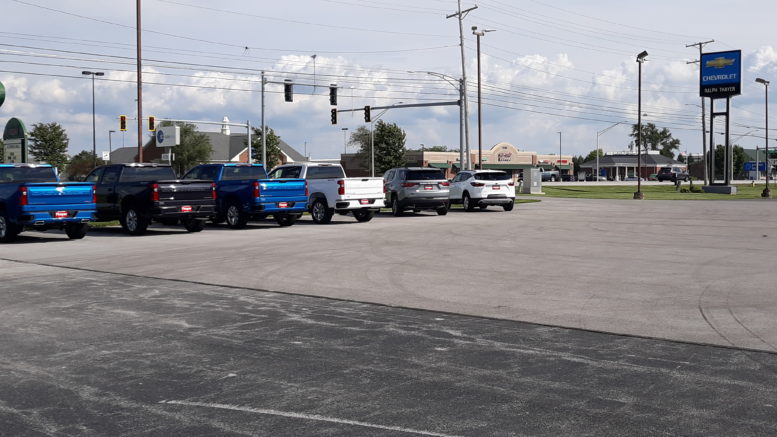By JAN LARSON McLAUGHLIN
BG Independent News
The effects of COVID continue to linger beyond health care – in places like scant retail shelves and sparse car dealerships lots.
The previously crowded showrooms at auto dealerships have yet to rebound – still crippled by computer chip shortages and supply chain delays.
For people shopping for vehicles that means little selection, long waits and higher prices.
For dealerships it’s meant some layoffs and a change in how customers shop for cars.
Brett Kime, the sales manager at Thayer Chevrolet in Bowling Green, recently talked about the ripple effects of the pandemic on the auto industry to the Bowling Green Exchange Club.
Prior to COVID, car dealerships could offer hundreds of options to customers shopping for new or used vehicles, said Kime, who has been with Thayer since 2015.
It was common for a customer to take a serious look at five or more cars, test drive about four, and talk pricing on a couple options. Within a few days, a customer could be driving home a shiny new vehicle.
With more than 120 cars on the lot at Thayer’s, it wasn’t unusual for a vehicle to be at the dealership for 200 days before being sold.
“If you sold it in 90 days, that was great,” Kime said.
Then March of 2020 came – shutting down some areas of business, but not yet debilitating the auto industry.
“We were relatively steady during the pandemic,” Kime said. “We were considered ‘essential,’ so we had the luxury of staying open.”
But then the ill-fated decision was made by auto manufacturers to cancel microchip orders, based on the belief that the demand for vehicles would dry up during COVID, Kime said. That, paired with the shift in microchips to the computer industry as more people began working at home, left the auto industry paralyzed to meet customer demands
“All of that put a big squeeze on the demand for chips,” Kime said, explaining that the typical vehicle contains 300 to 400 chips.
The result is a very different market for customers shopping for a new set of wheels. For example, prior to COVID, the sales lots were full of a rainbow of colored cars. Now, that color palette is limited.
“Now, it’s ‘this is what we’ve got. Do you like it?’” Kime said. “There are only so many cars to go around, and a lot of people who want them.”
Instead of 100 or so cars, his dealership may now have 10 cars for sale. And they are usually sold within a week of arrival.
“A lot of our cars are sold before they come in,” he said. “I don’t think we will have 100 vehicles on the lot any time soon.”
Pre-COVID, customers could order a custom vehicle with the longest wait time of about eight weeks. Now custom vehicles take eight to 12 months, Kime said.
And oftentimes, those vehicles are short on some features. It’s not unusual for cars to be sold to buyers with options like heated seats or blindspot monitoring to be installed later when the parts become available.
The impact goes far beyond the new car market, Kime explained. Car service departments are short on parts and rental cars are hard to come by. Used car prices have skyrocketed. And people involved in car crashes are finding themselves out of luck getting their vehicles fixed or securing a rental.
Slightly used rental cars used to be a good source of supply for dealerships. But that has “flip-flopped,” Kime said, with rental companies now going to dealerships for vehicles.
Consumers – especially when gas prices were higher earlier this year – were reluctant to drive to dealerships only to be disappointed by the lack of options. So 90% of car deals now start online or over the phone, Kime said.
“They want to know it’s there before they drive out,” he said. “They are doing all the research before talking to you.”
That has changed the whole face-to-face, firm handshake transactions that local dealerships have relied on for decades.
“The ripple effect of the pandemic is not just time and fewer features,” Kime said.
Services like Carvana are allowing prospective buyers to complete car purchases online.
Traditional dealerships have the option of doing deals with prospective buyers across the country, for more money, or selling their stock locally.
“We’ve chosen to prioritize our local customers,” Kime said.

